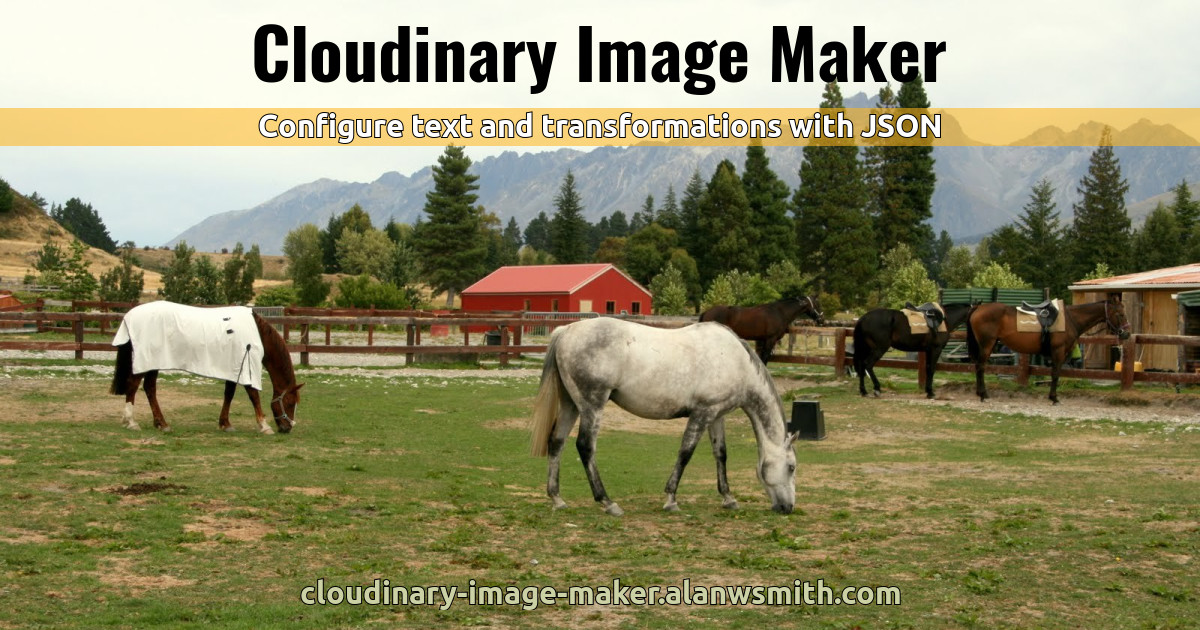Cloudinary Image Maker
Configuring cloudinary urls by hand is a tedious. I made this to make it easier. (It's json so it's still kinda tedious, but I find it easier than trying to mess with URLs. Especially when there are long text strings and escaping involved)
I use it to design templates for open graph (OG) images for the social network cards that show up when you share a link. It's nothing fancy. You edit the json in the box below and a preview of the images along with the url.
Check out these examples to get you started
Configure your transformation here:
Notes
- The examples that use "c_fill" cut off parts of the image to keep the desired perspective without distorting the image. Check out the docs for alternatives.
- Usage details are below, but I find it's easier to just click around the exmaples and look at the code to figure out how things work
- The cloudinary reference docs with all the stuff you can do are here
- The preview image width is constrained. The generated urls are unaffected by this and will resize to whatever dimensions you spec out
- Cloudinary's api does a bunch of stuff. This doesn't cover everything, but it'll get you pretty far. (and you can always just drop an entire string with whatever you want into a section to trigger it)
- You're supposed to be able to get images from Twitter and YouTube, but those failed for me even when I hand assembled the urls based of the documentation.
- The text samples show how to set fonts like 'Averia Sans Libre_19_bold'. Leave any spaces in the font names and they'll be formatted correctly when the url is generated.
- Some google fonts are available for use. I put together a list here: google fonts you can use in cloudinary transformations
- Use `:` as the seperator if you need to use an image from that's in a folder on in the cloudinary media libray. For example, `{ "l_og-images:1x1-white": [] }`
- There is a `letter_spacing` option but as far as I can tell it only increases spacing and can't contract it.
- You can pass font weights to the text calls (e.g. `Source Sans Pro_80_900`)
Usage
- You can use versions and folders in the BASE_IMAGE (e.g. "v1643773709/og-images/blank-v4")
- Trailing commas in the json don't work (formatters usually spread this across multiple lines, but something like this `['a', 'b', 'c',]` will choke). If you get an invalid json, that's the first thing to check
- Both object keys and values require double quotes
- Each "section" in the "SECTIONS" array represents code that will go in between slashes in the final url
- Each section is itself an array of item objects
- Each item object has exactly one key and one value
- The value of the item objects are always arrays of parameters
- The item object parameters array always exists, but it can be empty
- In sections, individual items are joined with commas
- If there are parameters on an item, those are joined to their corresponding key with ":" characters.
- Text is in the parameters is automatically encoded for urls
- Add an slash to escape quotes to use them in text (i.e. `\"`)
- Text must all be on one line in the json
- Paragraphs can be created by adding two newlines (i.e. `\n\n`)
- Commas in text are replaced with a double escape sequence to prevent them from conflicting with cloudinary's functionality
Possible Enhancements
- Setup so the tab key adds tabs in the box instead of tabbing to the next window
- Setup so that if there's an invalid json or the image isn't there the area doesn't collapse and shift the textarea around
- Add vim controls
- Made this thing responsive
- move off of document.execCommand() to the newer navigation api for copying the url to the clipboard
- Have the image switch to some type of loading spinner when a new image is being genearted
- Make a button that adds a new section stub
- Make a button that adds a new item to the last section
- Maybe handle newlines in strings to make it easier to see longer lines of text
- Store json history in local storage
- Setup the ability to post samples and code to twitter for storage, reference, and sharing
- Wire up prettier or another json formatter
- Add syntax highlighting
- Maybe split out the json sections to individual text areas
- Reverse the process so you can drop in a url that gets parsed out to a json for editing
- Examples with artistic filters
- Generate a page with font samples for available fonts
- Show a backup default image example
- Look at the layout stuff for making pdfs
- Show a colorblind assist example
- look at conditionals and variables for possibility of generative art
- see if masking layers can make better triangles
- Look into css sprite creation
- See how their responsive images work
- Look at custom functions and wasm stuff
